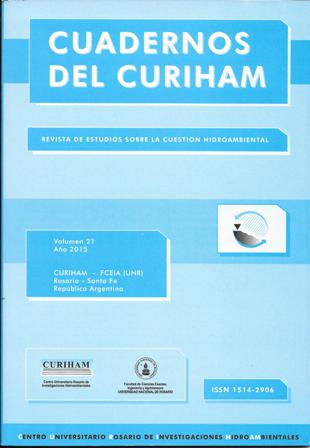Impacto del riego por goteo superficial y subterráneo y del drenaje en la distribución de la humedad y salinidad edáficas y en el rendimiento del tomate cultivado bajo cubierta
DOI:
https://doi.org/10.35305/curiham.v21i0.33Keywords:
Drain pipes, Tomato yield, Electrical conductivity, Sodium adsorption ratioAbstract
The grown under cover soils deteriorate by irrigation with saline water and lack of leaching by rain. Drainage
effects on tomatoes yield and soil moisture and salts distributions were evaluated. In a greenhouse 6 loins
were built, on three of them PVC pipes and tanks of 0.2 m³ were buried 0.5 m in the discharge. In the loins,
drip tapes were placed in three depths: 0.1 and 0.2 m (T1 and T2) and surface (T3), setting 6 treatments, 3
with drainage T1CD, T2CD and T3CD and 3 undrained T1SD, T2SD and T3SD. Volumetric water content
Wv was determined at 6 sites loin with sensors Decagon, 3 on the vertical axis and 3 on the horizontally axis
and pH, electrical conductivity CE and sodium adsorption ratio SAR in soil samples taken at the surface,
bottom and side of the loins. Weight and number of fruit over 10 plants per treatment were recorded. The
main results were: a) the differences between Wv media were statistically significant on the vertical axis, but
not for the horizontally axis; b) drainage favored both the Wv storage and the distribution uniformity; c) the
subsurface drip irrigation produced drainage volumes, not the surface drip; d) T2CD took top overall
tomatoes yield and fruit number; e) drainage practically unchanged pH, decreased the CE 35.8% and 17% the
SAR; f) the productive response was associated more to irrigation than salinity conditions.
Downloads
Downloads
Published
How to Cite
Issue
Section
License
Copyright (c) 2015 Leopoldo Génova, Ricardo Andreau, Pablo Etchevers, Marta Etcheverry

This work is licensed under a Creative Commons Attribution-NonCommercial-ShareAlike 4.0 International License.



























